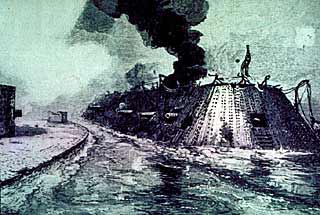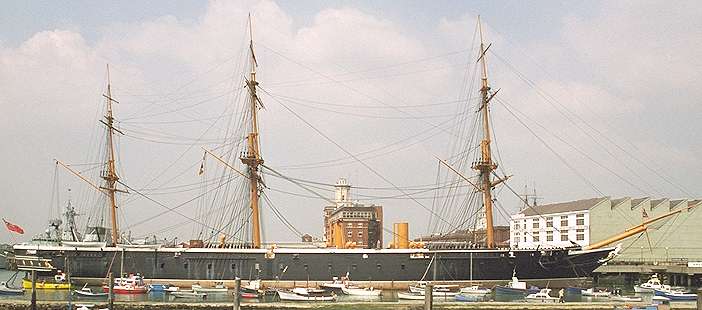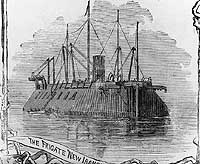May 03, 2002
EARLY IRONCLAD COMBAT: HOW GOOD WAS "THE BLACK SNAKE AMONGST THE RABBITS?"
Steven Den Beste emailed me the other day to ask his opinion of a correspondent's letter. The letter was in reference to Den Beste's post, here, on revolutions in naval architecture. The open question was whether the USS Monitor was the starting point of the 19th century naval architecture revolution culminating in dreadnoughts. James Rummel wondered if HMS Warrior, which Napoleon III called "the black snake amongst the rabbits" did not have prior title. Boy, did he ask the wrong person... so now, once again, you all get to be bored by a whole lot of information I collected once in my travels that, until this question comes up in discussion, has no practical use whatever.
 First off, there were at least three armoured steam frigates in the world before the Monitor's famous day on Hampton Roads: the British Warrior (launched 1860), HMS Black Prince (1861), and the French Gloire, which predated them both, having first sailed in 1860. Several other French and British ironclads were on the stays. As well, discussions of ironclads almost always ignore the Union riverine ironclad squadron which had played such an important role in the Fort Henry and Donelson fights, only a month before the Monitor's big day.
First off, there were at least three armoured steam frigates in the world before the Monitor's famous day on Hampton Roads: the British Warrior (launched 1860), HMS Black Prince (1861), and the French Gloire, which predated them both, having first sailed in 1860. Several other French and British ironclads were on the stays. As well, discussions of ironclads almost always ignore the Union riverine ironclad squadron which had played such an important role in the Fort Henry and Donelson fights, only a month before the Monitor's big day.
The British and French ships were, unlike the first American attempts, completely deep-seaworthy. (The Monitor would founder in ocean seas off Hatteras later in the war.) All bore the marks of early experimentation... observers said the Gloire's gunports were too low, and that the Warrior, one of the longest ships yet built, was too long and narrow). They were also hybrids, using sail for long journeys and coal-fired engines for battle.
 How would the Warrior have done in a fight against the Monitor or CSS Virginia (aka Merrimac)? Better than Den Beste gives it credit for, I would argue. In speed and acceleration, the British ship had huge advantages: it was one of the fastest steamships afloat. Its speed in full reverse (about 6 knots) was as fast as either of the American ships could do going forward. It was not very maneuverable, although possibly more maneuverable than the Virginia(which for all its hype, turned out to be a bit of an engineering nightmare). While its 4.5 inches of steel armor was less than the Monitor's 8 inches (or the Virginia's 4 inches of well-sloped plate), it was still sufficient cladding to stop all but close range naval fire (plunging shot was not a factor in these early ironclad vs. ironclad contests). On the downside, it was a big ship, making for a much larger target. But that of course, meant the Warrior had a much larger broadside, as well.
How would the Warrior have done in a fight against the Monitor or CSS Virginia (aka Merrimac)? Better than Den Beste gives it credit for, I would argue. In speed and acceleration, the British ship had huge advantages: it was one of the fastest steamships afloat. Its speed in full reverse (about 6 knots) was as fast as either of the American ships could do going forward. It was not very maneuverable, although possibly more maneuverable than the Virginia(which for all its hype, turned out to be a bit of an engineering nightmare). While its 4.5 inches of steel armor was less than the Monitor's 8 inches (or the Virginia's 4 inches of well-sloped plate), it was still sufficient cladding to stop all but close range naval fire (plunging shot was not a factor in these early ironclad vs. ironclad contests). On the downside, it was a big ship, making for a much larger target. But that of course, meant the Warrior had a much larger broadside, as well.
It all comes down to the guns, and it is here, of course, that the Monitor (the first successful turret ship, no argument there) sees its advantages coming into play. The broadsides of the ships, discounting all the guns incapable of penetrating heavy Monitor-style armour, can be described as follows:
Monitor: 2 11-in smoothbore muzzleloading Dahlgrens (turret mounted)
Virginia: 1 6.4-in rifled muzzleloading Brooke (plus 2 7-in Brookes as front and rear chasers); 3 smaller guns
Warrior: 5 110-pdr rifles*; 2 70-pdr rifle breechloading Armstrongs; 13 smaller guns
Gloire: 16 smaller guns
(*there is some question whether these would still have been the original Armstrong breechloaders, or similar-sized Blakely muzzleloaders, in 1862). Both the British rifles and the even bigger Dahlgrens on the Monitor could fire a heavy enough solid shell to crumple even the Monitor's own armour at close ranges; the Confederate's Brookes and the Warrior's smaller Armstrongs would have been somewhat less effective.
Let's restate the whole equation then, in simpler terms:
Monitor: Slow, Heavy armour, 2 heavy guns
Virginia: Slow, Heavy armour, 1 medium gun
Warrior: Fast, Medium armour, 7 medium/heavy guns
Gloire: Fast, Medium armour, lighter guns only
I won't bore you with the ballistic calculations, but it works out rather like this. The Monitor's guns could start doing damage on the Warrior at around 1,200 m, if they were firing solid shot at full charge. The Warrior would have to close to 500m for its 110-pdrs to start seriously damaging the thicker Monitor armour; but once it did get in that range, it would have the effective firepower of 7 Virginias, likely making the Monitor's turret uninhabitable in fairly short order. Alternatively, the British ship could easily stay outside of the Monitor's range if it chose, with its superior speed... but then it couldn't do the American any damage at all. More than likely, then, the Warrior would use its speed to run down the Monitor... the close-in fight that followed would be punishing, but would likely go the Royal Navy's way, and escape for the Monitor once it did would be all but impossible. Advantage: Moderate British.
What about the Virginia? Well, you have to understand the Virginia was not optimized for fighting other ironclads... slow, almost unsteerable, and with only one armour-piercing gun on each broadside, plus the chasers, guaranteeing it could never bring even two of its heavy guns to bear on a target at the same time (the rest of its guns were only good against wooden ships, which the Virginia proved capable of demolishing quite easily, of course.) So effectively even the Monitor outgunned it two-to-one from the get-go. The Confederates would have done better against the moderately armoured Warrior, against which its smaller guns could have had at least a marginal anti-armour capability. But again, the Warrior could have run the Virginia down in fairly short order, and taken the punishment from a range where its 110-pdrs could give back in more than equal measure. Given the massive speed advantage, the Warrior would have the advantage here, as well, though. Advantage: Moderate British.
The Gloire? Similar to the American wooden ships chewed up by the Virginia, the French ship simply had no guns capable of damaging the American ships' heavier armour. While it still could have done some damage to the lighter-armoured Warrior, the Gloire would have been chewed up by either American ironclad, assuming, like those American wooden ships off Hampton Roads, it didn't have the ability to just simply get away. It would have lasted longer than the Union steamships, but the result, either sinking or flight, would be predetermined. Advantage: Major American.
Given that both the Monitor and the Virginia had guns large enough to seriously damage their actual historical opponent, why didn't they? Well, the Virginia's complete ungainliness had a lot to do with it... it also, however, had much to do with the fact that the Virginia had only sailed with shell, not solid shot for its guns (not having expected the first ever Union ironclad to show up out of nowhere), which basically meant only its 7" front and stern guns had even a chance of seriously hurting the Monitor... with only shell, even the broadside 6.4's were useless against armour. So long as the nimbler Monitor kept to its flank, the Union ship was completely invulnerable.
As for the Monitor, it was so new its guns weren't even proofed, meaning they were only being fired at half-charge. Even at point blank range they could not possibly have done more than ding the Virginia as a result. The history books don't tell you this, and it's doubtful the participants on either side knew it, but from a strictly engineering perspective the best the Monitor could have hoped for at Hampton Roads was a draw: victory with its weakened guns was not possible (and defeat not very likely). But in a hypothetical battle with the Monitor firing its guns at full strength, I'd have to give the Union the odds, two guns to 1.
For counterpoint, this author here takes an even more favourable view of the Warrior's chances against the Monitor. I believe he overstates the case both for the Warrior's armour and the power of its guns (From what I have read, I don't believe the Warrior's light guns, Napoleonic-era 68 pdr smoothbore muzzleloaders, would have any effect on iron plate at all, at any range), and his conclusion, that the British captain would waste his ammunition plinking futilely at long range while the American chugged slowly towards him seems rather unlikely to me. Given the range superiority of the Union guns, I suspect it more likely the British ship would want to get close and stay close. (It would be the Monitor that would want to keep its distance... because of the position of its pilot house, it could not even fire its guns directly forward, making steaming towards the enemy a rather futile proposition.) Of course, this would make damage to the British ship as it ran in extremely likely, although I still believe the more powerful 7-gun-to-a-side battery would win out once both ships were within armor-damaging ranges.
 Interesting side note: the USS New Ironsides, which was commissioned in August of 1862, was a Warrior-type Union ironclad frigate that definitely could have given "the black snake" a run for its money. There's some interesting pictures of it here, showing how steam frigates of the Civil War era (both wooden and iron) looked when going into battle. It's a far cry from Nelsonian images of billowing sails, isn't it?
Interesting side note: the USS New Ironsides, which was commissioned in August of 1862, was a Warrior-type Union ironclad frigate that definitely could have given "the black snake" a run for its money. There's some interesting pictures of it here, showing how steam frigates of the Civil War era (both wooden and iron) looked when going into battle. It's a far cry from Nelsonian images of billowing sails, isn't it?
"endearingly macho" -- Mark Steyn
"wonderfully detailed analysis" -- John Allemang, Globe and Mail
"unusually candid" -- Tom Ricks, Foreignpolicy.com
May 2010
April 2010
March 2010
February 2010
January 2010
December 2009
November 2009
October 2009
September 2009
August 2009
July 2009
News:
The Globe and Mail
The Star
The Wash. Post
Opinion:
TNR
Slate
Washington Monthly
Rants:
Canadians
Penny
Janes
Cosh
The Hound
Coyne
Wells
Farrell, etc.
Steyn
Levant
Afghanistan
The Torch
Abu M.
Bill & Bob
Ghosts of Alex
Registan
Jari
Ink Spots
Ackerman
Kings
FRI
Embedded
Milnews.ca
Can-AFG
The Capt.
Etc.
TMLutas
Sullivan
Marshall
Kaus
Lileks
Reynolds
Welch
Farber
The Shark
Breen
Henley
Electrolite
Samizdata
Slotman
Simberg
Northrup
Bryant
Yglesias
Cole
Drum
Clients/Employers
(Past and Present):
U of T
Cdn. Forces
CG Magazine
LRC
Adrenaline Vault
